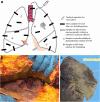Pulmonary pathology and COVID-19: lessons from autopsy. The experience of European Pulmonary Pathologists
- PMID: 32642842
- PMCID: PMC7343579
- DOI: 10.1007/s00428-020-02886-6
Pulmonary pathology and COVID-19: lessons from autopsy. The experience of European Pulmonary Pathologists
Abstract
Since its initial recognition in December 2019, Coronavirus disease 19 (COVID-19) has quickly spread to a pandemic infectious disease. The causative agent has been recognized as a novel coronavirus, severe acute respiratory syndrome coronavirus 2 (SARS-CoV-2), primarily affecting the respiratory tract. To date, no vaccines are available nor any specific treatment. To limit the number of infections, strict directives have been issued by governments that have been translated into equally rigorous guidelines notably for post-mortem examinations by international and national scientific societies. The recommendations for biosafety control required during specimen collection and handling have strongly limited the practice of autopsies of the COVID-19 patients to a few adequate laboratories. A full pathological examination has always been considered an important tool to better understand the pathophysiology of diseases, especially when the knowledge of an emerging disorder is limited and the impact on the healthcare system is significant. The first evidence of diffuse alveolar damage in the context of an acute respiratory distress syndrome has now been joined by the latest findings that report a more complex scenario in COVID-19, including a vascular involvement and a wide spectrum of associated pathologies. Ancillary tools such as electron microscopy and molecular biology used on autoptic tissue samples from autopsy are also significantly contributing to confirm and/or identify new aspects useful for a deeper knowledge of the pathogenetic mechanisms. This article will review and summarize the pathological findings described in COVID-19 until now, chiefly focusing on the respiratory tract, highlighting the importance of autopsy towards a better knowledge of this disease.
Keywords: Autopsy; COVID-19; Lung; Pandemic; SARS-CoV-2.
Conflict of interest statement
The authors declare that they have no conflict of interest.
Figures




References
-
- Wu F, Zhao S, Yu B, Chen YM, Wang W, Song ZG, Hu Y, Tao ZW, Tian JH, Pei YY, Yuan ML, Zhang YL, Dai FH, Liu Y, Wang QM, Zheng JJ, Xu L, Holmes EC, Zhang YZ. A new coronavirus associated with human respiratory disease in China. Nature. 2020;579:265–269. doi: 10.1038/s41586-020-2008-3. - DOI - PMC - PubMed
-
- Zhou P, Yang XL, Wang XG, Hu B, Zhang L, Zhang W, Si HR, Zhu Y, Li B, Huang CL, Chen HD, Chen J, Luo Y, Guo H, Jiang RD, Liu MQ, Chen Y, Shen XR, Wang X, Zheng XS, Zhao K, Chen QJ, Deng F, Liu LL, Yan B, Zhan FX, Wang YY, Xiao GF, Shi ZL. A pneumonia outbreak associated with a new coronavirus of probable bat origin. Nature. 2020;579:270–273. doi: 10.1038/s41586-020-2012-7. - DOI - PMC - PubMed
-
- Lukassen S, Chua RL, Trefzer T, Kahn NC, Schneider MA, Muley T, Winter H, Meister M, Veith C, Boots AW, Hennig BP, Kreuter M, Conrad C, Eils R. SARS-CoV-2 receptor ACE2 and TMPRSS2 are primarily expressed in bronchial transient secretory cells. EMBO J. 2020;39:e105114. doi: 10.15252/embj.20105114. - DOI - PMC - PubMed
Publication types
MeSH terms
LinkOut - more resources
Full Text Sources
Medical
Miscellaneous

